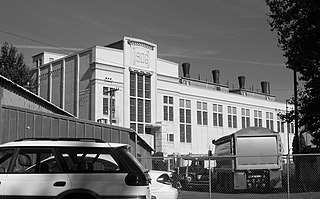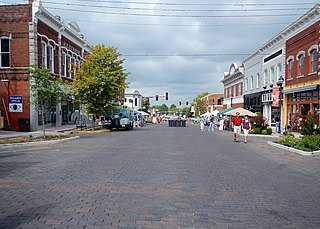
The Fort Smith Trolley Museum is a streetcar and railroad museum in Fort Smith, in the U.S. state of Arkansas, which includes an operating heritage streetcar line. The museum opened in 1985, and operation of its streetcar line began in 1991. Four vehicles in its collection, a streetcar and three steam locomotives, are listed on the National Register of Historic Places (NRHP). The now approximately three-quarters-mile-long (1.2 km) streetcar line also passes four NRHP-listed sites, including the Fort Smith National Historic Site, the Fort Smith National Cemetery, the West Garrison Avenue Historic District and the 1907 Atkinson-Williams Warehouse Building, which now houses the Fort Smith Museum of History.

The Georgetown Steam Plant, located in the Georgetown neighborhood of Seattle, Washington, was constructed in 1906 for the Seattle Electric Company to provide power for Seattle, notably for streetcars.

Croton Dam is an earth-filled embankment dam and powerplant complex on the Muskegon River in Croton Township, Newaygo County, Michigan. It was built in 1907 under the direction of William D. Fargo by the Grand Rapids - Muskegon Power Company, a predecessor of Consumers Energy. The 40-foot-high (12 m) dam impounds 7.2 billion U.S. gallons (6 billion imp. gal/27 billion L) of water in its 1,209-acre (489 ha) reservoir and is capable of producing 8,850 kilowatts at peak outflow. It was listed on the National Register of Historic Places in 1979.

The Crescent Brass and Pin Company Building is located at 5766 Trumbull Street in Detroit, Michigan. It was listed on the National Register of Historic Places in 2003. It is currently known as the Research Lofts on Trumbull.

The Detroit–Columbia Central Office Building is a building located at 52 Selden Street in Midtown Detroit, Michigan. It is also known as the Michigan Bell Telephone Exchange. The building was listed on the National Register of Historic Places in 1997.

Engine Company No. 28 is a former Los Angeles Fire Department fire station on Figueroa Street in Downtown Los Angeles. Built in 1912 at a cost of US$50,000, the structure served as an operating fire station until it was closed in 1967. One of the first reinforced concrete fire stations in the city, it is a Class A fire-proof structure built of brick, hollow tile and concrete. In 1979, the building was listed in the National Register of Historic Places.

The Rogers Commercial Historic District is a historic district in the central business district of Rogers, Arkansas. When it was first listed on the National Register of Historic Places in 1988, it was known as the Walnut Street Historic District; this was changed when the district was enlarged in 1993. The district encompasses a portion of the city's central business district, whose historical significance extends from about 1885 to the end of the Second World War.

The University of Arkansas Campus Historic District is a historic district that was listed on the National Register of Historic Places on September 23, 2009. The district covers the historic core of the University of Arkansas campus, including 25 buildings.

The Benton County Courthouse is a courthouse in Bentonville, Arkansas, United States, the county seat of Benton County, built in 1928. It was listed on the National Register of Historic Places in 1988. The courthouse was built in the Classic Revival style by Albert O. Clark and anchors the east side of the Bentonville Town Square.

The General Electric Switchgear Plant is a historic factory building located at 421 North 7th Street at Willow Street in the Callowhill neighborhood of Philadelphia, Pennsylvania. It was built in 1916, and is a seven-story, seven bay by nine bay, reinforced concrete building with brick facing. It was designed by William Steele & Company for General Electric, which manufactured electric switchboard equipment there.

The Borden Milk Co. Creamery and Ice Factory is a historical site in Tempe, Arizona. Built originally as an ice plant, it was altered to also produce pasteurized bottled milk. The Pacific Creamery Plant was sold in 1927, and it operated under the Borden name until its closure in 1953. The building stood empty until it was reopened as Four Peaks Brewery, a restaurant and regional brewery. The Borden operation had enough impact on the city that a new park was designated "Creamery Park" in 1999.

The Raney House is a historic house at 1331 Monte Ne Road in Rogers, Arkansas. It is a two-story American Foursquare house, with a hip roof and a wraparound porch. It was built c. 1912 out of rusticated concrete blocks, a building material popular in the area for residential construction in the area between 1910 and 1925. This house is one of the most elaborate built from them in the area, with curved architraves between the porch columns and corners quoined with smooth blocks to highlight their appearance.

The Rife House was a historic house at 1515 South Eighth Street in Rogers, Arkansas. It was a modest single-story house, built out of concrete blocks cast to resemble rusticated stone. It had a gable-on-hip roof, with a shed-roof extension to the rear, and a full-width porch across the front. The porch was supported by four fluted columns fashioned out of concrete blocks. Built c. 1920, this was a local example of a vernacular house built using a once-popular construction material.

The Bellows Falls Co-operative Creamery Complex is a historic industrial property in Bellows Falls, Vermont. Developed over a period of about 40 years beginning c. 1906, the complex, with two surviving buildings, it represents one of Vermont's largest commercial enterprises of the period. The property, located on the eastern side of Bellows Falls Island, was listed on the National Register of Historic Places in 1990.

Unit A of the Climber Motor Car Factory is a historic industrial building at 1823 East 17th Street in Little Rock, Arkansas. It is a large wood frame structure, topped by a gabled monitor roof. Its walls are concrete block for the bottom 2 feet (0.61 m), and wood frame between concrete pillars above. The building was constructed in 1919 for the Climber Motor Company, the only automobile manufacturer founded in the state, and was the only part actually built of a planned multi-building complex. The company manufactured automobiles here until 1924, after which it was used by Command-Aire to build small aircraft, and by the Great Northern Paper Company to manufacture toilet paper.

The National Guard Armory-Pine Bluff is a former National Guard armory at 623 West 2nd Avenue in Pine Bluff, Arkansas. It is a two-story masonry structure, built out of concrete and buff brick with Art Deco styling, included a castellated parapet. It was built in 1931, and was the first state-owned militia building in Jefferson County. It served as a state armory until 1974, housing the 39th Tank Company, and now houses vocational classrooms.

The Lockesburg High School Gymnasium is a historic school gymnasium at 128 East Main Street in Lockesburg, Arkansas. Built in 1952-53, it is a utilitarian rectangular building, built out of concrete blocks and resting on a poured concrete foundation. Its main facade is the north side, with a center entrance shaded by an awning, and symmetrically placed porthole windows on either side. Most of the building's interior is taken up by the actual playing area, with tiered bleachers on two sides. The interior finishes are largely original materials. It was built to meet growing post-World War II demand for improved school facilities, and has historically served as a venue for most of the community's larger-scale social events. The school closed in 1968; the building is now owned by Cossatot Community College.

The National Old Line Insurance Company Building is a historic office building at 501 Woodlane Street in Little Rock, Arkansas. It is a modern six-story structure of concrete and steel, occupying much of the city block bounded by Woodlane, Capitol, Sixth, and Victory Streets. It is directly across Woodlane Street from the Arkansas State Capitol, and presently houses state offices. It was designed by Arkansas architect Yandell Johnson and built in 1953-54, with an addition in 1964-54. The exterior is characterized by alternating horizontal bands of windows and limestone panels, which encircle the structure. It is regarded as one of the best examples in the state of the International style of architecture.

The Empire Life Insurance in America Building is a historic commercial building at 2801 West Roosevelt Road in Little Rock, Arkansas. It was built in 1959-60 to a design by the Little Rock firm of Wittenberg, Delony, and Davidson, and is a significant local example of the International style of commercial design. It is a two-story structure of steel and concrete, predominantly faced in glass, aluminum, and fieldstone. The building was given an award by the regional branch of the American Institute of Architects in 1961.

The Block Realty Building is a historic commercial building at 723 West Markham Street in Little Rock, Arkansas. It is a two-story structure, built out of steel and concrete, with a flat roof. It is supported by corten steel columns, with its first floor predominantly finished in glass, and the upper level in aggregate concrete tiles. It was built in 1964 to a design by architect-engineer Eugene Levy, and is a good local example of commercial Mid-Century Modern architecture.




















